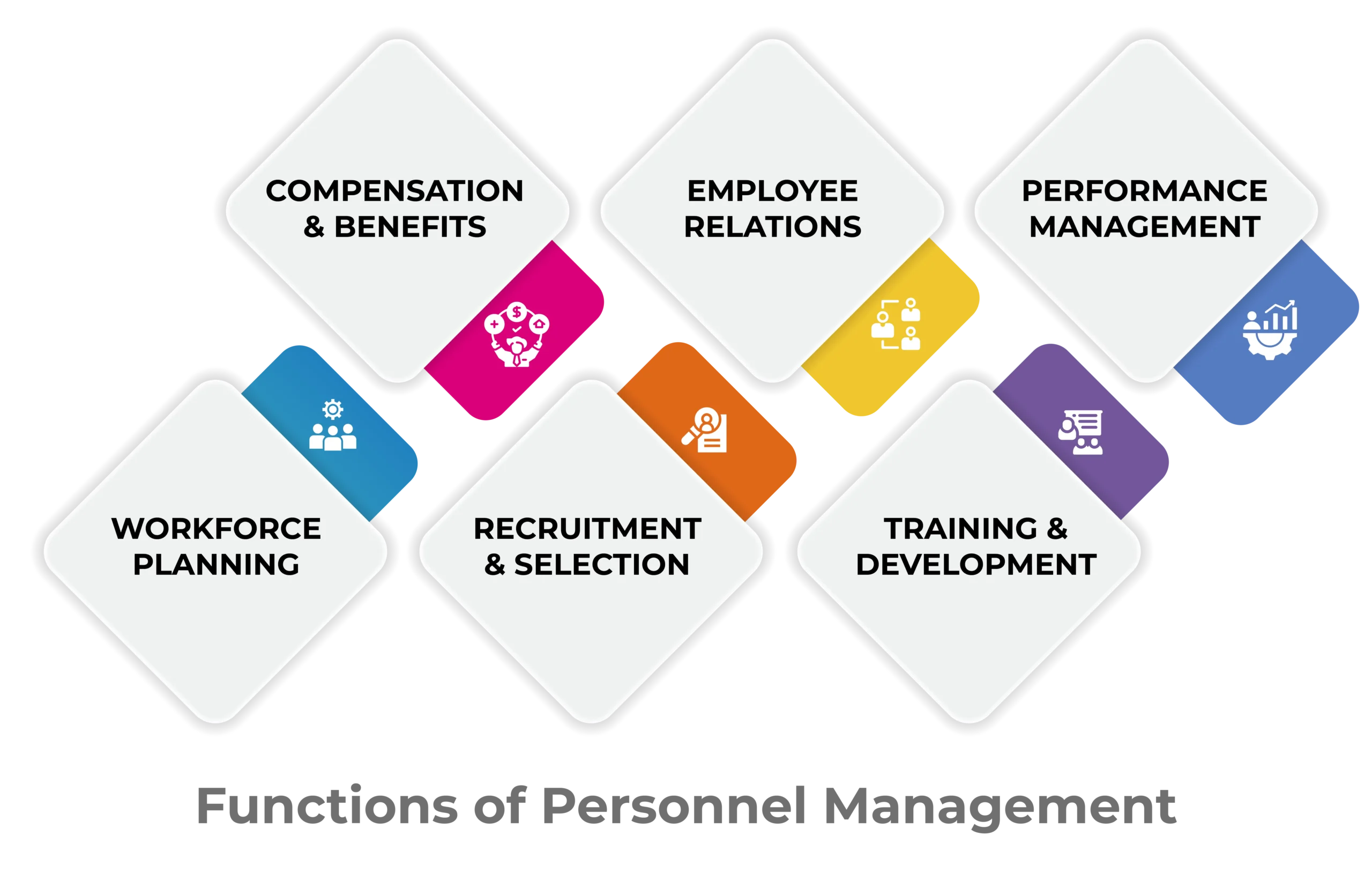What is Personnel Management?
Personnel management is the process of managing a company’s employees, which includes hiring, training, and compensating them for their time and effort. It is an administrative function focussing on the relationship between the employees and the employer.
Personnel management ensures smooth business operations. It involves numerous activities like workforce planning, recruitment, training, compensation, and employee relations, which enable the staff to undertake their duties well. Historically, personnel management in HRM was limited to maintaining employee records and enforcing company policies, but it has gradually evolved to include employee engagement and well-being too.
Personnel management is primarily concerned with administrative tasks related to human resources, including maintenance of employee records, ensuring compliance with labour laws, handling employee grievances, and managing their welfare. While modern HRM takes a strategic approach to workforce development, personnel management focuses on ensuring that employees are managed effectively within the organization’s structure. The primary goal of the concept of personnel management is to optimize the use of human resources to maximize organizational efficiency while maintaining employee satisfaction and legal compliance.
Functions of Personnel Management
Personnel management includes several key functions that enable improved workforce efficiency and organizational success. Each of these functions plays a crucial role in ensuring that employees are hired, trained, and managed effectively.
The major functions of personnel management include:

1. Workforce Planning
Workforce planning, or manpower planning, is the process of forecasting an organization’s workforce needs. It involves analysing current employees’ capabilities to predict future requirements and implementing strategies to ensure that the right number of employees with the right skills are available when needed. Proper manpower planning helps businesses avoid issues such as understaffing, which can limit productivity, or overstaffing, which leads to unnecessary operational costs.
A well-structured workforce plan involves several stages, such as:
- Demand Forecasting: It estimates the number of employees required, based on business growth and expansion plans.
- Supply Analysis: This stage evaluates the existing workforce’s skills and identifies potential gaps.
- Gap Analysis: Gap analysis identifies differences between workforce supply and demand, helping you understand the exact workforce requirements.
- Action Planning: During this stage, you develop the hiring and training plans to address the skill and workforce gaps identified in the last stage.
2. Recruitment & Selection
Recruitment and selection are one of the most essential aspects of personnel management as it enables organizations to attract and hire the right employees. The recruitment process involves attracting qualified candidates for job vacancies, while selection involves interviewing and assessing them and choosing the most suitable one for the role.
A dedicated recruitment management system usually includes the following steps:
- Job analysis
- Job posting
- Sourcing candidates
- Screening applicants
- Conducting interviews
- Offering employment
- Onboarding recruits.
A structured recruitment process ensures that the organization hires employees who are the ideal fit for its culture and long-term goals. Modern recruitment strategies also involve AI-driven hiring platforms, psychometric analysis, and data-driven decision-making to optimize candidate selection.
3. Training & Development
Training and development of employees is essential for improving employee skills and productivity. Hence, the nature of personnel management involves identifying skill gaps within the organization and providing employees with training management system and programs to enhance their capabilities and upskill them effectively.
An effective training strategy enhances employee performance and prepares them for leadership roles, ensuring business continuity. It also helps companies have a competitive advantage over others. Additionally, organizations with well-developed learning programs often see higher retention rates and improved job satisfaction.
A well-structured training and development process includes the following:
- Orientation programs for new employees
- On-the-job training for skill enhancement
- Workshops and seminars for professional growth
- Leadership development programs for future managers
- Cross-training to improve workforce flexibility.
4. Compensation & Benefits
Personnel management also involves defining fair compensation and benefits to attract and retain top talent. Compensation refers to wages or salaries provided to employees in exchange for their work, while benefits include additional perks such as health insurance, retirement plans, paid leave, bonuses, etc. Providing competitive compensation and benefits enhances job satisfaction, reduces turnover, and improves overall employee morale.
Ideally, a robust compensation system should be developed considering the following factors:
- Industry standards and market trends
- Employee performance and contributions
- Cost of living adjustments
- Legal requirements and compliance
- Incentive programs.
5. Employee Relations
Managing employee relations is another crucial function of personnel management as it involves developing a positive work environment. Companies maintain employee relations by resolving conflicts, handling employee grievances, and ensuring fair treatment of all staff members.
A strong employee relations strategy enhances workplace harmony and reduces disputes, increasing employee engagement. Hence, companies that invest in employee relations programs often experience higher job satisfaction rates, increased collaboration, and lower absenteeism rates.
Key aspects of employee relations include:
- Implementing fair workplace policies
- Encouraging open communication
- Addressing workplace conflicts
- Ensuring prompt employee grievance resolutions
- Promoting a culture of respect and inclusion.
6. Performance Management
Performance management involves monitoring and evaluating employee performance to ensure that individual and organizational goals are met. Effective performance management system helps employees stay motivated and align their efforts with organizational objectives. Organizations utilizing modern performance management software can provide real-time feedback, developing a work culture of balanced and steady performance.
Personnel management uses various tools and methods for performance management, including:
- Regular performance appraisals
- Setting clear performance goals and KPIs
- Providing constructive feedback
- Identifying areas for improvement
- Recognizing and rewarding top performers.
Importance of Personnel Management
Personnel management is essential for any organization as it ensures a structured and efficient workforce. It is especially relevant for modern organizations, as it provides the following benefits:
- Optimized Operational Efficiency: Personnel management ensures that employees are effectively utilized, leading to smoother business operations and increased productivity.
- Enhanced Employee Satisfaction: Fair policies, good working conditions, and recognition programs contribute to employee motivation and satisfaction.
- Complete Legal Compliance: Personnel management also ensures complete adherence to labour laws, employment regulations, and workplace policies, reducing the risk of legal disputes.
- Assured Talent Retention: By focusing on employee well-being, career growth, and competitive compensation, personnel management helps retain top talent.
- Reduced Workplace Conflicts: A structured approach to employee relations minimizes disputes and creates a positive work culture.
Difference Between Personnel Management and Human Resource Management
Personnel management and Human Resource Management share common goals but differ in their approach. Personnel management takes a more administrative and compliance-focused approach, whereas HRM is strategic, focusing on employee engagement, talent development, and overall workforce optimization.
The following table highlights their differences:
| Factors | Personnel Management | Human Resource Management |
| Focus | Administrative functions | Strategic employee development |
| Approach | Reactive | Proactive |
| Employee Treatment | Workforce as a Resource | Employee as an Asset |
| Decision-making | Centralized | Decentralized |
Challenges in Personnel Management
There are various challenges in implementing a robust personnel management strategy. Following are some of the common ones that organizations must navigate:
➔ Resistance to Change
Employees often resist new policies and procedures, making it difficult to implement changes effectively. Resistance often comes in the wake of getting used to existing techniques and methodologies, as people often find it hard to adjust themselves to changes.
➔ Limited Focus on Engagement
Traditional personnel management focuses more on administrative functions rather than employee engagement and development. It often leads to resentment among the staff as they are required to adjust to the changes undertaken despite having no tangible reward in sight.
➔ Compliance with Labour Laws
Constantly evolving labour laws and employment regulations require organizations to stay updated and ensure compliance. Traditional personnel management strategies often ignore these changes, leading to friction between HR and the management. However, modern personnel management practices have mitigated a lot of these issues by being flexible.
➔ Balancing Organizational & Employee Needs
Finding the right balance between company profitability and employee satisfaction can be challenging. Legacy personnel management methods were skewed towards business prosperity at the cost of employee engagement and satisfaction, resulting in an imbalance between organizational and employee needs.
➔ Adapting to Technological Changes
The rise of HR technology has shifted many personnel management functions to automated systems, requiring adaptation and digital transformation. Employees and HRs often find themselves having to adjust their work according to these technological changes and hence, often resist these new changes.
➔ Managing Diversity
A diverse workforce presents challenges related to inclusion, cultural differences, and workplace dynamics. While modern personnel management has mitigated a lot of these issues, some friction might occur when implementing these policies. Hence, HRs are required to take additional precautions especially when dealing with a diverse workforce.

